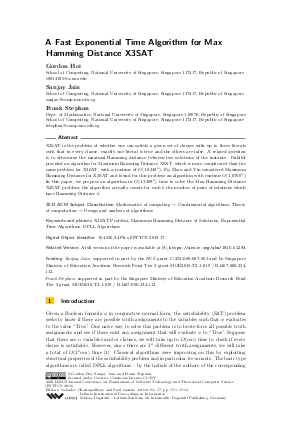A Fast Exponential Time Algorithm for Max Hamming Distance X3SAT
Authors Gordon Hoi, Sanjay Jain, Frank Stephan
-
Part of:
Volume:
39th IARCS Annual Conference on Foundations of Software Technology and Theoretical Computer Science (FSTTCS 2019)
Part of: Series: Leibniz International Proceedings in Informatics (LIPIcs)
Part of: Conference: IARCS Annual Conference on Foundations of Software Technology and Theoretical Computer Science (FSTTCS) - License:
 Creative Commons Attribution 3.0 Unported license
Creative Commons Attribution 3.0 Unported license
- Publication Date: 2019-12-04
File

PDF
LIPIcs.FSTTCS.2019.17.pdf
- Filesize: 0.5 MB
- 14 pages
Document Identifiers
Related Versions
-
A full version of the paper is available at [Hoi et al., 2019], https://arxiv.org/abs/1910.01293.
Subject Classification
ACM Subject Classification
- Mathematics of computing → Combinatorial algorithms
- Theory of computation → Design and analysis of algorithms
Keywords
- X3SAT Problem
- Maximum Hamming Distance of Solutions
- Exponential Time Algorithms
- DPLL Algorithms
Metrics
- Access Statistics
-
Total Accesses (updated on a weekly basis)
0Document
0Metadata
Abstract
X3SAT is the problem of whether one can satisfy a given set of clauses with up to three literals such that in every clause, exactly one literal is true and the others are false. A related question is to determine the maximal Hamming distance between two solutions of the instance. Dahllöf provided an algorithm for Maximum Hamming Distance XSAT, which is more complicated than the same problem for X3SAT, with a runtime of O(1.8348^n); Fu, Zhou and Yin considered Maximum Hamming Distance for X3SAT and found for this problem an algorithm with runtime O(1.6760^n). In this paper, we propose an algorithm in O(1.3298^n) time to solve the Max Hamming Distance X3SAT problem; the algorithm actually counts for each k the number of pairs of solutions which have Hamming Distance k.
Cite As Get BibTex
Gordon Hoi, Sanjay Jain, and Frank Stephan. A Fast Exponential Time Algorithm for Max Hamming Distance X3SAT. In 39th IARCS Annual Conference on Foundations of Software Technology and Theoretical Computer Science (FSTTCS 2019). Leibniz International Proceedings in Informatics (LIPIcs), Volume 150, pp. 17:1-17:14, Schloss Dagstuhl – Leibniz-Zentrum für Informatik (2019)
https://doi.org/10.4230/LIPIcs.FSTTCS.2019.17
BibTex
@InProceedings{hoi_et_al:LIPIcs.FSTTCS.2019.17,
author = {Hoi, Gordon and Jain, Sanjay and Stephan, Frank},
title = {{A Fast Exponential Time Algorithm for Max Hamming Distance X3SAT}},
booktitle = {39th IARCS Annual Conference on Foundations of Software Technology and Theoretical Computer Science (FSTTCS 2019)},
pages = {17:1--17:14},
series = {Leibniz International Proceedings in Informatics (LIPIcs)},
ISBN = {978-3-95977-131-3},
ISSN = {1868-8969},
year = {2019},
volume = {150},
editor = {Chattopadhyay, Arkadev and Gastin, Paul},
publisher = {Schloss Dagstuhl -- Leibniz-Zentrum f{\"u}r Informatik},
address = {Dagstuhl, Germany},
URL = {https://drops.dagstuhl.de/entities/document/10.4230/LIPIcs.FSTTCS.2019.17},
URN = {urn:nbn:de:0030-drops-115799},
doi = {10.4230/LIPIcs.FSTTCS.2019.17},
annote = {Keywords: X3SAT Problem, Maximum Hamming Distance of Solutions, Exponential Time Algorithms, DPLL Algorithms}
}
Author Details
- School of Computing, National University of Singapore, Singapore 117417, Republic of Singapore
- School of Computing, National University of Singapore, Singapore 117417, Republic of Singapore
Funding
- Jain, Sanjay: supported in part by the NUS grant C-252-000-087-001 and by Singapore Ministry of Education Academic Research Fund Tier 2 grant MOE2016-T2-1-019 / R1467-000-234-112.
- Stephan, Frank: supported in part by the Singapore Ministry of Education Academic Research Fund Tier 2 grant MOE2016-T2-1-019 / R1467-000-234-112.
References
-
Burkhard Monien and Robert Preis. Upper bounds on the bisection width of 3- and 4-regular graphs. Journal of Discrete Algorithms, 4(3):475-498, 2006.

-
David Eppstein. Small maximal independent sets and faster exact graph coloring. Proceedings of the Seventh Workshop on Algorithms and Data Structures, Springer Lecture Notes in Computer Science, 2125:462-470, 2001.

-
David Eppstein. Quasiconvex analysis of multivariate recurrence equations for backtracking algorithms. ACM Transactions on Algorithms, 2(4):492-509, 2006.

-
Fedor V. Fomin and Dieter Kratsch. Exact Exponential Algorithms. Texts in Theoretical Computer Science, EATCS, Springer, Berlin, Heidelberg, 2010.

-
Serge Gaspers. Exponential Time Algorithms: Structures, Measures, and Bounds. VDM Verlag Dr. Müller, 2010.

-
Serge Gaspers and Gregory B. Sorkin. Separate, measure and conquer: faster polynomial-space algorithms for Max 2-CSP and counting dominating sets. ACM Transactions on Algorithms (TALG), 13(4):44:1-44:36, 2017.

-
Gordon Hoi and Frank Stephan. Measure and conquer for Max Hamming Distance XSAT. International Symposium on Algorithms and Computation, ISAAC 2019, LIPIcs, 149:18:1-18:20, 2019.

- Gordon Hoi, Sanjay Jain and Frank Stephan. A fast exponential time algorithm for Max Hamming X3SAT. arXiv, 2019. Technical Report version of this paper. URL: http://arxiv.org/abs/1910.01293.
-
Linlu Fu, Junping Zhou and Minghao Yin. Worst case upper bound for the maximum Hamming distance X3SAT problem. Journal of Frontiers of Computer Science and Technology, 6(7):664-671, 2012.

-
Magnus Wahlström. Algorithms, measures and upper bounds for satisfiability and related problems. PhD thesis, Department of Computer and Information Science, Linköping University, 2007.

-
Martin Davis and Hilary Putnam. A computing procedure for quantification theory. Journal of the ACM, 7(3):201-215, 1960.

-
Martin Davis, George Logemann and Donald W. Loveland. A machine program for theorem proving. Communications of the ACM, 5(7):394-397, 1962.

-
Ola Angelsmark and Johan Thapper. Algorithms for the maximum Hamming distance problem. Recent Advances in Constraints, International Workshop on Constraint Solving and Constraint Logic Programming, CSCLP 204, Springer Lecture Notes in Computer Science, 3419:128-141, 2004.

-
Oliver Kullmann. New methods for 3-SAT decision and worst-case analysis. Theoretical Computer Science, 223(1-2):1-72, 1999.

-
Pierluigi Crescenzi and Gianluca Rossi. On the Hamming distance of constraint satisfaction problems. Theoretical Computer Science, 288(1):85-100, 2002.

-
Richard Wesley Hamming. Error detecting and error correcting codes. Bell System Technical Journal, 29(2):147-160, 1950.

-
Satya Gautam Vadlamudi and Subbarao Kambhampati. A combinatorial search perspective on diverse solution generation. Thirtieth AAAI Conference on Artificial Intelligence, pages 776-783, 2016.

-
Vilhelm Dahllöf. Algorithms for Max Hamming Exact Satisfiability. International Symposium on Algorithms and Computation, ISAAC 2005, Springer Lecture Notes in Computer Science, 3827:829-383, 2005.

-
Vilhelm Dahllöf. Exact Algorithms for Exact Satisfiability Problems. PhD thesis, Department of Computer and Information Science, Linköping University, 2006.

